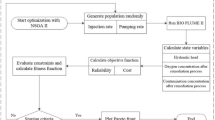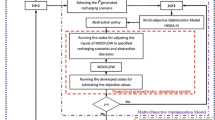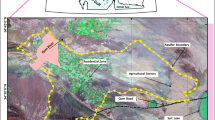Abstract
A methodology is developed for optimal remediation of groundwater aquifers under hydraulic conductivity uncertainty. A multi-objective management method based on a pump-and-treat remediation technology, is proposed. The pumping rates and well locations are the decision variables and two objectives are chosen: minimization of contaminated groundwater in the aquifer and minimization of remediation cost. A Monte Carlo simulation method is used to cope with hydraulic conductivity uncertainty. A number of equally probable realizations of hydraulic conductivity are created and a Pareto front is obtained using a modified multi-objective Genetic Algorithm. A penalty function is utilized to maintain the algebraic sum of pumping and recharging rates equal to zero. Since Monte Carlo simulations are CPU time consuming, a method is proposed to identify the few significant realizations which have an effect on the optimal solution (critical realizations). A Pareto front with an assigned probability is derived, so that the decision maker can make decisions with specified reliability. In a case study with 100 realizations, only 11 realizations were found critical and need be considered. The remaining 89 realizations consistently obtain low ranks for all designs considered and do not affect decisions at 95% reliability level. Thus these realizations need not be considered which implies a 89% savings in computer time. The designs obtained using the critical realizations, retain a similar reliability for new realizations not considered in the design process.
Similar content being viewed by others
References
Andricevic R, Kitanidis PK (1990) Oprimization of the pumping schedule in aquifer remediation under uncertainty. Water Resour Res 26(5):875–885
Erickson M, Mayer A, Horn J (2002) Multi-objective optimal design of groundwater remediation systems: application of the niched Pareto genetic algorithm (NPGA). Adv Water Resour 25:51–65
Espinoza FP, Minsker BS, Golberg DE (2005) Adaptive hybrid genetic algorithm for groundwater remediation design. J Water Resour Plan Manage 131(1):14–24
Gen M, Cheng R (2000) Genetic algorithms and engineering optimization, 495. Wiley, New York
Guan J, Aral MM (1999) Optimal remediation with well locations and pumping rates selected as continuous decision variables. J Hydrol 221:20–42
Mantoglou A, Wilson JL (1982) The turning bands method for simulation of random fields using line generation by a spectral method. Water Resour Res 18(5):1379–1397
Maskey S, Jonoski A, Solomatine DP (2002) Groundwater remediation strategy using global optimization algorithms. J Water Resour Plan Manage 128(6):431–440
McDonald GM, Harbaugh WA (1988) A modular three-dimensional finite-difference ground-water flow model. Techniques of water resources investigations 06-A1. United States Geological Survey, Washington, DC
McKinney DC, Lin M-D (1996) Pump-and-treat ground-water remediation system optimization. J Water Resour Plan Manage 122(2):128–136
Park C-H, Aral MM (2004) Multi-objective optimization of pumping rates and well placement in coastal aquifers. J Hydrol 290:80–99
Ranjithan S, Eheart JW, Garrett HJ (1993) Neural network-based screening for groundwater reclamation under uncertainty. Water Resour Res 29(3):563–574
Singh A, Minsker B (2003) Uncertainty based multi-objective optimization of groundwater remediation at umatilla chemical depot. In: Proceedings of the American Society of Civil Engineers (ASCE) Environmental and Water Resources Institute (EWRI) World Water and Environmental Resources Congress 2003, Philadelphia PA
Singh A, Minsker B, Goldberg DE (2003) Combining reliability and pareto optimality – an approach using stochastic multi-objective genetic algorithms. In: Proceedings of the American Society of Civil Engineers (ASCE) Environmental and Water Resources Institute (EWRI) World Water and Environmental Resources Congress 2003, Philadelphia PA
Wagner JB, Gorelick SM (1989) Reliable aquifer remediation in the presence of spatially variable hydraulic conductivity: from data to design. Water Resour Res 25(10):2211–2225
Wong HS, Yeh WW-G (2002) Uncertainty analysis in contaminated aquifer management. J Water Resour Plan Manage 128(1):33–45
Zheng C, Wang PP (1999) MT3DMS: a modular three-dimensional multispecies transport model for simulation of advection, dispersion and chemical reactions of contaminants in ground water systems: documentation and user’s guide. Contact Report SERDP-99-1, US Army Engineer Research and Development Center, Vicksburg, MS
Author information
Authors and Affiliations
Corresponding author
Rights and permissions
About this article
Cite this article
Mantoglou, A., Kourakos, G. Optimal Groundwater Remediation Under Uncertainty Using Multi-objective Optimization. Water Resour Manage 21, 835–847 (2007). https://doi.org/10.1007/s11269-006-9109-0
Received:
Accepted:
Published:
Issue Date:
DOI: https://doi.org/10.1007/s11269-006-9109-0




